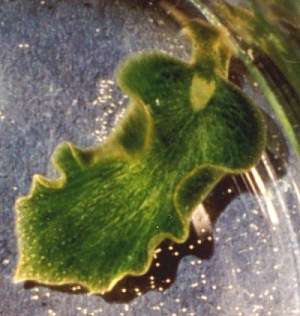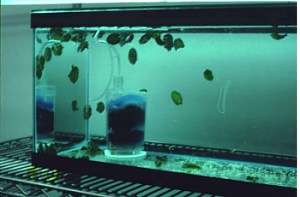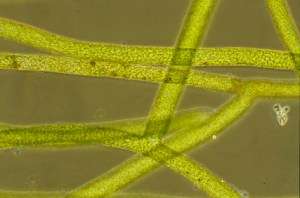Solar-powered Elysia chlorotica
February 26, 2000
From: Liz Summer

Hi Dr Rudman,
I am a chloroplast molecular biologist in the lab of Dr. Mary Rumpho at Texas A&M University. We are studying the genetic and biochemical basis for the unusual longevity of chloroplast activity in Elysia chlorotica. We couldn't help but notice the absence of images of E. chlorotica on your web site!
Here are some images (courtesy of Dr. Mary Rumpho) of Elysia chlorotica (Gould), and their symbiont chloroplast source, the alga Vaucheria litorea (C. Agardh). The animals were collected in late November from Martha's Vineyard, MA, USA. As the aquarium image shows, they are maintained in artificial sea water without algal food for up to 10 months following collection. In culture, the animals live by photosynthetic carbon fixation, through which they obtain enough energy to even lay eggs. Their ultimate, synchronized death seems to be due to a viral infection endemic in the slug population rather then loss of chloroplast activity.
We also grow V. litorea in order to compare chloroplast activity in the animal vs. the algae. The attached image shows a close up of the algal filaments. Vaucheria is a siphonaceous algae - this means it is designed like a straw - a hard outer cell wall but with few cross walls. It has a multinucleated cytoplasm and many chloroplasts. Because of this design, it is easy for the slug to obtain a full load of chloroplasts by piercing the outer wall and sucking out the inside. V. litorea is a chromophytic algae (containing chlorophyll a & chlorophyll c) that grows as hair-like mats and is ecologically important in stabilizing muddy bottoms.
Elizabeth Summer, Ph.D.
Research Associate
Horticultural Sciences Dept
Texas A&M University
College Station, Texas, USA
elizsum@aol.com


Dear Liz,
Thanks very much for the illustrations and the interesting review of Elysia chlorotica and its ability to live so long without normal feeding. As a long-time fan of Solar-powered Sea Slugs I had been hoping someone would fill the gap, as E. chlorotica certainly deserved some recognition.
If you would like to keep us informed of your work I am sure there are many interested people (other than me) who will read it. Things that would be of interest would be a photo of chloroplasts in an Elysia and an EM photo of a chloroplast. Perhaps you could let me know of any major gaps in my list of chloroplast symbiosis references.
Best wishes,
Bill Rudman.
Related messages
-
Lateral gene transfer between multicellular organisms
From: Bill Rudman, August 15, 2007 -
Elysia chlorotica "ghosts".
From: Skip Pierce, June 15, 2005 -
Elysia chlorotica from Martha's Vineyard, USA
From: skip pierce, May 14, 2005 -
Elysia anatomy
From: Kathleen Archer, November 13, 2003 -
New Paper on Elysia chlorotica
From: Elizabeth J. Summer, September 22, 2000 -
Trouble finding Elysia chlorotica
From: Jack Teng, August 4, 2000 -
Re: Elysia chlorotica & mating chains
From: Kathe R. Jensen, May 18, 2000 -
Elysia chlorotica & mating chains
From: Liz Summer, May 17, 2000 -
Re: Elysia sp. 7 from Texas
From: Kathe R. Jensen, May 7, 2000 -
Elysia from Texas
From: Cathy Porter, February 23, 2000
